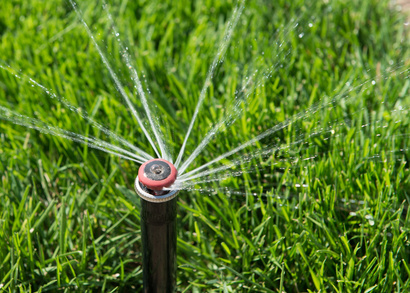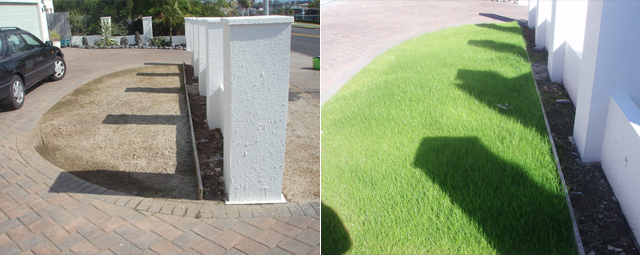Lawn Care Tips
How to keep your grass healthy and avoid a parched lawn.
Check out our tips to help your new lawn grow strongly and stay healthy.
Frequently Asked Questions
Your lawn will grow in approximately three weeks after hydroseeding if conditions allow and watering has been undertaken as directed.
The lawn will strike in approximately three weeks, depending on the season. However it will need another two to three weeks to develop a strong healthy root system to withstand rigorous use.
Install an appropriate irrigation system or rig up a temporary sprinkler on a battery timer that will water your lawn automatically. Be sure to check for local water restrictions.
Grass that starts to go a little yellow is in need of nutrients. A healthy, well-nourished lawn should remain a vibrant green colour.
Most well-known brands of lawn fertiliser will suffice in most situations. Or you could buy a simple soil-testing kit from your garden centre and test the soil to see what it needs. Or consult your lawn care professional.
Cutting the grass right to the soil will kill the grass, and may even promote weed growth. Keeping the grass above than 25mm keeps some moisture around the grass and allows sunlight to be absorbed.
Parched lawn? Here’s what to do.
Hot and dry spells can cause long-term lawn damage. Here are some steps to consider when you notice the first signs of stress:
- An application of wetting agent to help soil absorb and hold water, meaning your lawn doesn’t dry out so easily between waterings.
- A top dressing application of premium quality organic lawn soil (weed free) to aid the ability of the soil to feed and stimulate root growth.
- Review mowing techniques and mowing heights to help retain moisture around the root zone.
- Review watering systems or programmes to help build your lawn resilience in times of stress.
- Consider oversowing and fertilising to build back the lawn and repair damage.
- Plan for any more advanced remediation required in the forthcoming autumn growing season.

Routine maintenance.
- Mowing. Mowing at the correct height and correct frequency, with not too much off at any time. Make sure you have sharp mowing blades.
- Fertilisation. This should be specific to grass and soil type. See our seasonal care tips below to ensure you fertilise at the right time of year and with the correct slow-release formula when your lawn can best use the nutrients available. All new lawns are hungry for nitrogen-rich fertiliser as provided when your new lawn is installed. But remember that ongoing applications are key to a healthy lawn.
- Irrigation. All lawns needs water – some more than others. They need plenty of water when germinating, with more frequency and less duration. Think ‘little and often.’ Once the lawn is established, watering can take place with less frequency and more duration for healthy deep rooting grass. It is important not to over-water your lawn, causing moss and fungal problems, or to under-water your lawn, causing it to dry out, get stressed and even die.
- Aeration. Dethatching and coring at the right time of year and for specific grass and soil types allows good air circulation to the grass. This stimulates growth, allowing better drainage and access for oxygen, nutrients and water to the roots.
- Pest and Disease Control. Usually a symptom of poor management Look to any or all of the above to correct first. Healthy grass will be able to better withstand pests and diseases. Spraying should be the last option.
Maintenance is of course not limited to these activities. It may also include over-sowing where grass has thinned out, and top-dressing with lawn compost to add organic matter to your lawn.

Seasonal care tips.
Spring and autumn are the main grass growing seasons, while winter and summer are all about maintaining your lawn through periods of stress.
Spring
- Prepare and sow new lawns after spraying to control any weeds.
- Aerate if necessary.
- Dethatch any build-up of dead grass or organic matter.
- Fertilise in early spring.
- Over-sow with new seed to any bare patches on existing lawns.
- Top dress with organic matter.
- Top up fertiliser to get through summer.
Summer
- Raise mowing height.
- Top dressing.
- Irrigation – long, deep infrequent watering
- If sowing lawns over summer, look to make use of irrigation and possibly covering with shade cloth.
- Spray off, in late summer, any lawn areas to be resown in autumn.
Autumn
- This is the prime growing season so prepare to sow new lawns.
- Over-sow existing lawn.
- Dethatch.
- Aerate.
- Apply a slow-release fertiliser to nurture over winter.
- Top dress.
Winter
- Switch your mower from mulching to the catcher, as the grass will need access to light.
- Keep leaves off lawns.
- Cut back any trees that are shading lawn to let more light in.
- Control broadleaf weeds by hand or spraying so they don’t crowd out dormant or slow growing grasses.
- Watch and spray preventively for diseases and pests.
- Sharpen mower blades, ready for the vigorous growth of spring.
“Our lawn turned out fantastic,
…absolutely amazing product and service!
Oh yes we will 100% use you again.”
N SINGH
Dannemora

